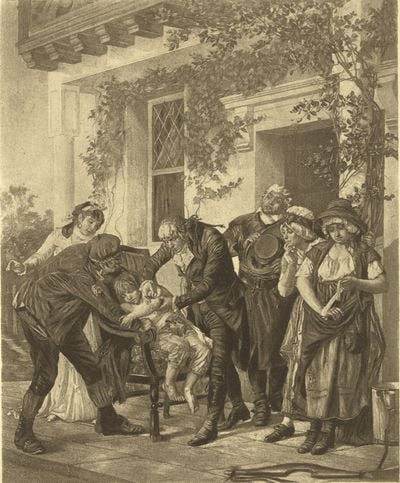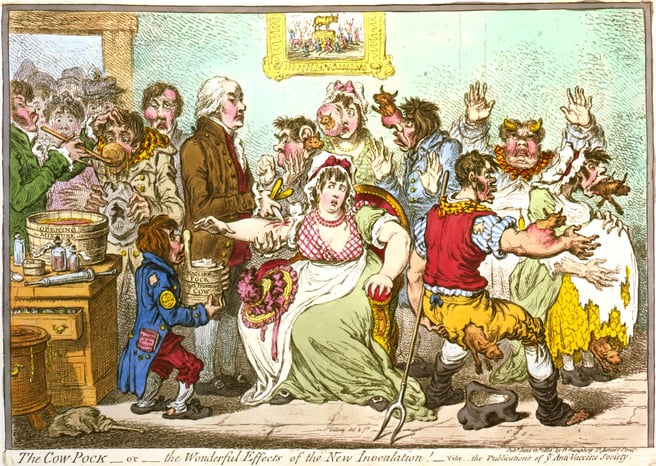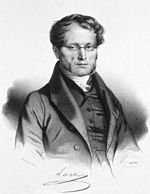1 min read
SCOPE: Powering the Future of Clinical Research
Meet Veristat at SCOPE: Powering the Future of Clinical Research February 2-5, 2026
🔬 Advancing Clinical Research with...
 Edward Jenner vaccinating James Phipps, a boy of eight, on May 14, 1796. Lithograph by French artist Gaston Mélingue from the late 19th century.
Edward Jenner vaccinating James Phipps, a boy of eight, on May 14, 1796. Lithograph by French artist Gaston Mélingue from the late 19th century.
James Lind (Naval Surgeon)
James Lind is known as the pioneer of clinical trials. He conducted one of the first clinical trials by studying the effect of citrus fruit on scurvy in 1747.
[vimeo 15051229 w=500 h=375]
‘What the Industrial Revolution Did for Us: Modern Medicine’ from James Lind Library on Vimeo.
Edward Jenner (British Physician)
Edward Jenner is credited with creating the world's first vaccine: the smallpox Vaccine. He noticed that farmers exposed to cowpox were protected from smallpox. In 1796 he tested this theory by injecting a farmer's boy with cowpox and then proved that the boy was now immune to smallpox. According to the BBC, Jenner's vaccine had a lot of critics and the clergy deemed vaccinations an ungodly act. However, the desire to live won out over the clergy's opinion and vaccinations soon became commonplace.
 A cartoon by British satirist James Gillray, showing cows emerging from different parts of the body after receiving Jenner's vaccine.
A cartoon by British satirist James Gillray, showing cows emerging from different parts of the body after receiving Jenner's vaccine.
In the 1800's, the growth of hospitals and of mathematical theory of probabilities as a discipline helped to increase opportunities for medicine to become more scientific. In 1810, the United States could boast of only two general hospitals: the Pennsylvania Hospital (founded in 1756) and the New York Hospital (founded in 1791). Massachusetts General Hospital (MGH) was opened in 1821 and was intended to care for the poor (as were most hospitals founded in the 19th century, since the wealthy were cared for at home). During the mid-to-late 19th century, Harvard Medical School was located adjacent to MGH. Today, the Charles River is nearly 1,000 feet to the west of the hospital. However, until about 1860, the river's edge extended as far as the hospital and had a wharf that was the landing for patients and supplied that arrived at the hospital by boat.
In the 1820's, 11 physicians met in Washington, D.C. to establish the U.S. Pharmacopeia (USP), the first compendium of standard drugs for the United States. The USP created a system of standards, a system of quality control, and a national formulary. Only 217 drugs that met the criteria of "most fully established and best understood" were admitted.
Pierre Charles Alexander Louis
 A drawing of Pierre Charles Alexander Louis from Fielding Hudson Garrison's "An introduction to the history of medicine"
A drawing of Pierre Charles Alexander Louis from Fielding Hudson Garrison's "An introduction to the history of medicine"
Pierre Charles Alexander Louis is most well-known for developing the "numerical method". He used this method to conduct trials that disputed François-Joseph-Victor Broussais' theory that bloodletting was an effective treatment for fevers. In 1834, Louis published a treatise in the American Journal of Medical Sciences titled "An essay on clinical instruction". This essay proved that bloodletting is ineffective for fevers caused by pneumonia and also detailed the numerical method, which added improved outcomes for patients and added objectivity to trials.
Ignaz Semmelweis
Ignaz Semmelweis pioneered antiseptic procedures. He is most well known for discovering that the death rate due to the contraction of puerperal fever (a bacterial infection of the female reproductive tract after miscarriage or childbirth) could be drastically reduced if hospital staff washed their hands with a chlorinated lime solution. This change resulted in the death rate dropping from 10%-50% to l.27%. Unfortunately, the medical community disagreed with Semmelweis' observations and he was committed to an asylum in 1865. He was beaten by the guards and died from infected wound only 14 days after being committed.
Louis Pasteur
Louis Pasteur was a French biologist who is known as the "Father of Microbiology" and is revered for many things, including: the principals of pasteurization, microbial fermentation, and vaccination; and for his proposal of the germ theory. In fact, his work in the area of germ theory disproved the previously popular theory of spontaneous generation. Like many people before him who made groundbreaking discoveries, some of Pasteur's discoveries were quite controversial. In fact, a 1995 analysis of his notebooks revealed that Pasteur had been deceptive when giving accounts of some of his experiments regarding fermentation and the anthrax vaccine.
[youtube https://www.youtube.com/watch?v=OXdbQ1JkX7c]
Ronald Fisher
Ronald Fisher developed the concept of randomization and conducted the first three randomized tuberculosis trials between 1847 and 1851.
Wilhelm Röntgen
Wilhelm Röntgen discovered the X-ray in 1895.
Robert Koch
Robert Koch is often referred to as the "Other Father of Microbiology". His research led him to create Koch's postulates, a series of generalized principals linking specific diseases to specific microorganisms. He was the founder of bacteriology and identified the causes of tuberculosis, cholera, and anthrax. He received a Nobel Prize for his work with tuberculosis.
1 min read
Nov 20, 2025 Veristat Events
🔬 Advancing Clinical Research with...
1 min read
Oct 22, 2025 Veristat Events
Veristat is excited to attend the ASH Annual Meeting and...